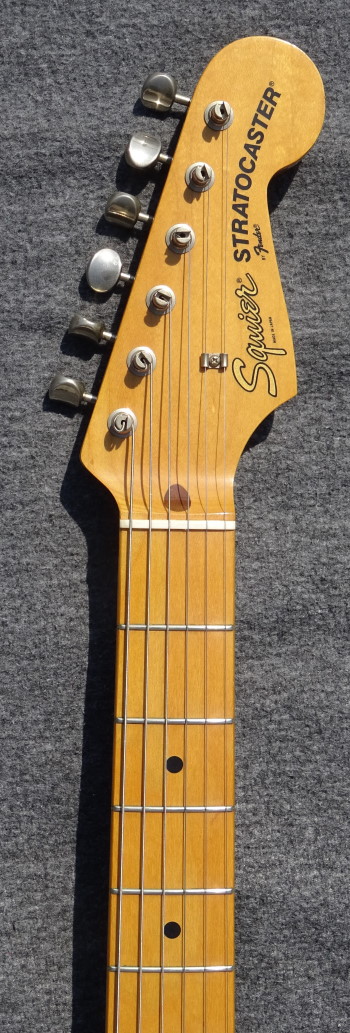













'83 STRATOCASTER SQUIER JV 57 Reissue Made in Japan Sunburst All original in near Mint Conditions Super! FE145
The original reissue. The JV (Japanese Vintage) series was launched by Fender in an effort to win back the custom it was loosing to the booming Japanese copy market. Fender needed to go back to their roots and make guitars like they used to; the result were these excellent vintage spec'd instruments built at the famous Fuji-Gen factory in Japan, by the luthiers that were responsible for the copies that were hurting Fenders sales! These JV serials have become highly sought after due to their rarity and phenomenal build quality and playability. Our '83 is no exception, with a gorgeous neck and a beautiful Sunburst two tone finish in Excellent Conditions with Hard Case..
Alder body 1-piece Maple neck and Fretboard (Measure: 25,5") Nut width: 42,2mm Single ply pickguard (8 screw) 21 vintage frets 3x Fender Japan vintage voiced single-coil pickups 1x Master Volume control 2x Tone control 3-way selector Stratocaster bridge and tremolo system
https://www.youtube.com/watch?v=KRsyZiILecE
https://www.youtube.com/watch?v=D2T_6N-_W-M

The
story began on March 11, 1982, when Fender CBS entered into a collaboration
agreement with the "Fuji Gen-Gakki Mfg Co." for the creation of a line of
electric guitars to be produced in Japan according to the specifications and
designs of the parent company (for the first time even the hardware components
were the same). For this reason, the newly formed Fender Japan did not produce
economic instruments (as opposed to the current Squier division), but guitars
based on US projects which in many cases also shared the hardware of the then
brand new American Vintage series (Fullerton was). They were so incredible that
Dan Smith himself, then CEO of Fender, was stunned by the products that churned
out the new production line. On the very first stock of the Squier JV models the
Fender logo was imprinted in large size, and the Squier decal on the tip of the
headstock; this detail, combined with the high quality of the proposed
instruments, generated some problems when exporting these instruments outside of
Japan, as buyers could easily confuse the new Fender Japan instruments with the
US sisters (some traders also tried to making money, making the first Japan pay
for the price of the USA to unsuspecting buyers).
Thus it was thought to remedy the problem by changing the decals to be applied
on the headstock for models destined for the foreign market. The specimens
intended for export were thus equipped with a more recognizable and large Squier
logo, a cubital font like the one on some "Smith era" and the wording "By
Fender" in small size, as if to claim its authorship of forms and design.
The first series was boasted two versions of the same model for Precision and
Stratocaster, namely '57 (maple neck) and '62 (rosewood neck), while for the
Telecaster only the '52 model was initially available (in practice a "Blackguard
"With almond-shaped eyes). For the domestic and English markets, there were also
soft cases supplied, in fabric or leather, of the" molded "type with the Squier
logo on the front pocket, when they arrived in Italy, however, they were
marketed without case.
For the domestic and English markets, soft cases, in fabric or leather, of the
"molded" type with the Squier logo on the front pocket were also made available;
The sale in Europe began right behind strong requests from European dealers, as
initially the JV was a production not intended for export (and Fender Japan,
moreover, still now produces models intended for the domestic market only). The
English market was the first to receive a stock of Squier JV destined for sale,
followed shortly thereafter by the other European markets.